Audi has announced it will sell only electric cars by the 2026 model year. But this model year, it is already selling partially-electric cars like the A7, which has both a gas-burning engine and electric motors/batteries to reduce the amount of gas being burned.
The gas mileage isn’t especially great – but that’s not really the point when it comes to a high-end car like the A7.
While the hybrid version can go about 24 miles without burning any gas at all, the main attraction here – beyond the good looks – is the extra (and sooner) power you get with an electric motor; the same “sell” that sells purely electric Teslas.
But purely electric cars make you stop for lengthy recharge sessions, especially if you run out of range of a “fast” charger – which still takes half an hour or more to get you going again.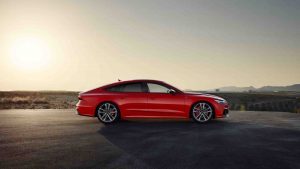
A hybrid like the A7 doesn’t make you stop, because it can recharge itself as you drive, as well as by plugging it in when you don’t mind stopping.
There are some other interesting attributes that differentiate the A7 from otherwise similar sedans, including the Audi’s ability to open its rear liftgate – which gives opens up about twice the cargo-space available in a conventional sedan of about the same size with a trunk.
What It Is
The A7 is a mid-sized luxury-sport sedan that’s about the same length as Audi’s A6 sedan – the model it’s based on – but with a lower roofline and a liftgate/expansive cargo area in the rear instead of a closed off and much smaller trunk.
It is a similar expression of the sedan with “coupe-like” styling first pioneered by Mercedes-Benz with the CLS, which is a lower/sleeker take on the more formally styled E-Class sedan – but more practical than its inspiration, which still has a trunk and less than than half the cargo capacity.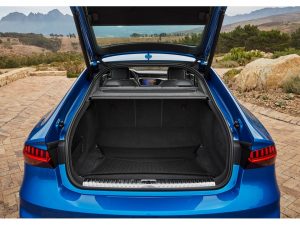
All versions of this Audi have partially electric drivetrains – as is also true of the Benz CLS. But Audi also offers a plug-version of the A7 that can operate solely on the electric side of its hybrid powertrain for up to 24 miles.
Mercedes doesn’t offer that, yet. (The CLS will be revised for 2022 and may offer a plug-in option, too.)
Prices start $69,200 for the Premium trim, which comes standard a mild-hybrid drivetrain that cycles the gas engine off and on as you drive.
A top-of-the-line Prestige trim with the new plug-in hybrid drivetrain that enables the A7 to travel as far as 24 miles without burning any gas at all – and which can be recharged without burning any gas at all – lists for $80,250.
All A7s come standard with Audi’’s Quattro all-wheel-drive system.
What’s New
The plug-n drivetrain is the main change for 2021.
What’s Good
Electrification without the hassles of electrification.
Crossover cargo capacity – without the crossover.
A relative bargain – relative to cross-shops like the Benz CLS and BMW 8 Gran Coupe.
What’s Not So Good
Electrification is expensive.
Minimal ground clearance (4.2 inches) renders standard AWD not much help in snow.
No non-hybrid option offered.
Under The Hood
The A7 offers two hybrid drivetrain options, one that plugs in and one that does not. That’s nothing new as plug-in and “regular” hybrids have been around for years. What’s new in this case is that the hybrid drivetrain with the smaller engine is the stronger of the two drivetrains – as well as the most fuel efficient.
What you might not expect is that the A7’s standard engine is a V6 engine. That’s unusual these days, even in high-end cars like this Audi.
It’s a 3.0 liter turbocharged V6 paired up with a “mild hybrid” 48 volt belt-starter system similar in function to the system Benz offers in the CLS. It cycles the engine off as often as possible – as when coasting, decelerating or not moving – to reduce fuel consumption and decrease emissions. The system offers up 335 horsepower and 369 ft.-lbs. of torque. A seven speed automatic transmission and Quattro AWD are standard.
This combo can get the A7 to 60 in 5.2 seconds and rates 22 MPGs in city driving and 29 MPGs on the highway.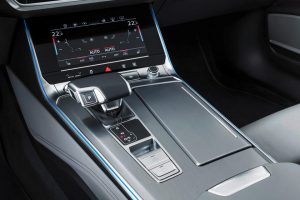
The A7’s optional engine is a turbocharged 2.0 liter four cylinder engine, paired with a more aggressive hybrid system that can cycle the engine off – and keep it off for up to 24 miles of electric-only driving. When you run out of electric-only range, you can keep on driving, too – because the gas engine will automatically come back on and provide both propulsion and power to recharge the 14.1 kilowatt-hour battery pack as you drive.
Or, you can plug the A7 in for a recharge – if you like. If you have the time to wait.
This is the big advantage the A7 and plug-in hybrids like it have over purely electric cars, which have to be plugged in when you run out of range, forcing you to wait.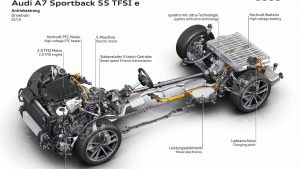
Whether you have time or don’t.
This combo also has the most horsepower – 362, total (and the same 369 ft.-lbs. of torque) but – another surprise – costs you a few tenths in the 0-60 sprint, which takes about 5.6 seconds. The reason for that has to do with weight. The plug-in version is about 400 pounds heavier (4,773 lbs.) than the standard version 4,332 lbs.)
But your reward is an overall fuel efficiency gain of about 5 MPG as well as the ability to roll without burning any gas at all – for 24 miles or so. 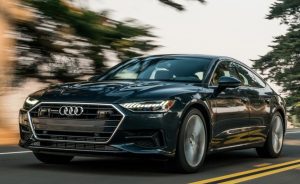
On The Road
Thank the motor gods for the *asterisk.
Audi says it will sell only “electric” cars in about five years from now. Lucky for Audi buyers, this will probably include hybrid electric cars like the A7. Being able to plug in is nice. Not having to stop even more so.
Speaking of that.
The A7’s standard hybrid drivetrain doesn’t “practice” combustion interruptus. Well, it does, but you will not know it because the system cycles the gas-burning V6 off and on without the obvious paint-shaker effect of the stop-start systems that are in common use in many new cars and meant to achieve the same thing (keep the gas engine off to reduce gas burning as well as gas emitting as often as possible) on the cheap.
And they feel it.
Because you feel it. Roll to a stop, the engine cuts off. Green light, the engine cranks back to life – after a slight but noticeable pause. And while the engine’s not running, the AC often isn’t, either – as it is often mechanically driven, by the running engine. All of this restarting is also hard on the starter battery, which you’ll probably have to replace sooner than you otherwise would.
And these more primitive systems don’t have the ability to cycle the engine off when the car is moving, so the gas savings are trivial – about 1 MPG overall- and probably outweighed by the costs of more frequent starter battery replacement – and nevermind the cost to your peace of all that racket.
The A7’s system eliminates the racket by “spinning up” the engine using a belt starter system directly connected to the engine’s crankshaft rather than a conventional starter motor bolted to the flywheel – with 48 volts rather than the usual 12 providing four times the re-start juice. The transitions are seamless and – for now – make it feasible for Audi to continue offering a V6 by reducing the emissions of gas (mainly carbon dioxide) this larger engine would otherwise produce and which would for that reason cause Audi problems with government regulations, especially in its European home turf market – where the regulations are even more severe than they are becoming here.
Gas mileage is no big whoop, though. 22 city and 29 highway averages out to about 25 MPG, which is about what I got during a week-long test drive. I can squeeze 15 MPG out of my ’76 Trans-Am – and it has a 7.5 liter carbureted V8.
Not that it matters much given what the A7 is and how much it costs, but the fact tells you much about the reasons for all this electrification – which is not to save gas.
Or money.
The TDI diesels Audi used to make used less gas (well, diesel) and cost a great deal less but they produced too much of the verboten gasses and so they’re gone and we’re the poorer for it.
But, at least the V6 remains – for now.
And you don’t have to stop – for now.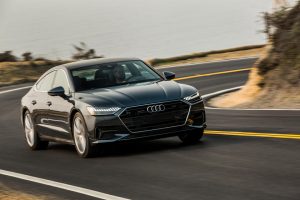
The standard V6/mild-hybrid can go more than 500 highway miles before it needs to stop for gas and the plug-in hybrid never makes you worry about how long you’ll have to stop. It’s also as seamless in its transitions as the milder hybrid version, but gives you the silent drive option that is one of the big sells for electric cars.
Speaking of that.
With either drivetrain, the A7 is exceptionally quiet – even relative to the current very high standard for near-silence inside most cars once the doors are closed to the outside. It is not an exciting car to drive, but it is an extremely nice drive home from the office or wherever you’re headed.
The A7 emulates the idea Mercedes (and BMW) came up with first – of making a sedan with “coupe-like” styling, to give people who have to have four doors but would like to drive something that looks more like the two-doors they’d prefer to drive, if they could.
With the added practicality of a rear liftgate rather than a small trunk.
The A7 is 195.6 inches long overall and so about the same size as the Benz CLS, which is 196.4 inches long overall. But the Benz only has 11.9 cubic feet of space in its trunk while the Audi has 24.9 cubic feet underneath its rear liftgate. This is a big difference – on the order of more than twice as much space. It makes the A7 much more capable of carrying four people and their stuff than the Benz.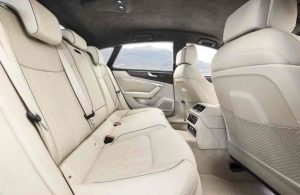
Another area where the Audi’s numbers are higher than the Benz’s is rearseat legroom, which the A7 has two inches more of (37 inches) than the Benz (35 inches) which is again not a small difference.
But there is another difference, less practical.
The A7’s lower roofline vs. the A6 it’s based on slopes more steeply backward – to give it that sleek, “coupe-like” profile. Which reduces available headroom in back by about an inch (vs. the A6) to 37.1 inches. It’s a small difference but one that taller passengers may notice.
Something else you may notice – when it snows – is that all-wheel-drive isn’t much help when the car it’s installed in sits as low to the ground as the A7 does. You’ve only got 4.2 inches of clearance, which isn’t a lot of margin when there’s several inches of snow on the ground. In a car like the A7, the main advantage of AWD is better wet weather and dry-handling traction.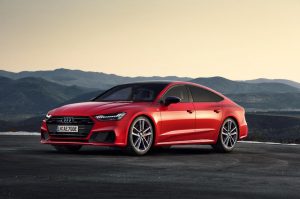
All trims come standard with a sunroof, leather seats and three-zone climate control. You can add a larger secondary LCD screen and a digital instrument panel; these come standard in the Premium Plus and Prestige trims, which also get a higher-performance Bang & Olufsen audio rig.
Massaging seats for the driver and front seat passenger are also available, but this option is only offered with the top-of-the-line Prestige trim.
The Rest
Electrification is expensive.
The A7 – even the mild hybrid version – is a $70,000 car. Before taxes and tags. The new plug-in crests $80,000.
Even in decline-and-fall stage American dollars, that’s a lot of money for a mid-sized luxury sedan, even one that looks as nice as this one does. Cars in this class used to start around $50,000 – and not way back in 1990, either. But that was when it was possible to build them government-compliant without partial or full electrification. Those days are gone, especially now that the Orange Man is, too.
Like him or not, the OM was the only thing standing in the way of partial or full electrification – of everything. And he’s no longer standing there. Which is why Audi – and several others – have committed to electrification of everything. It is because they have no choice.
And soon, neither will we.
The Bottom Line
The A7 is an electrified car without the big downsides of electric cars – excepting the price of electrification.
. . .
Got a question about cars, Libertarian politics – or anything else? Click on the “ask Eric” link and send ’em in!
If you like what you’ve found here please consider supporting EPautos.
We depend on you to keep the wheels turning!
Our donate button is here.
If you prefer not to use PayPal, our mailing address is:
EPautos
721 Hummingbird Lane SE
Copper Hill, VA 24079
PS: Get an EPautos magnet or sticker or coaster in return for a $20 or more one-time donation or a $10 or more monthly recurring donation. (Please be sure to tell us you want a magnet or sticker or coaster – and also, provide an address, so we know where to mail the thing!)
My eBook about car buying (new and used) is also available for your favorite price – free! Click here. If that fails, email me at [email protected] and I will send you a copy directly!


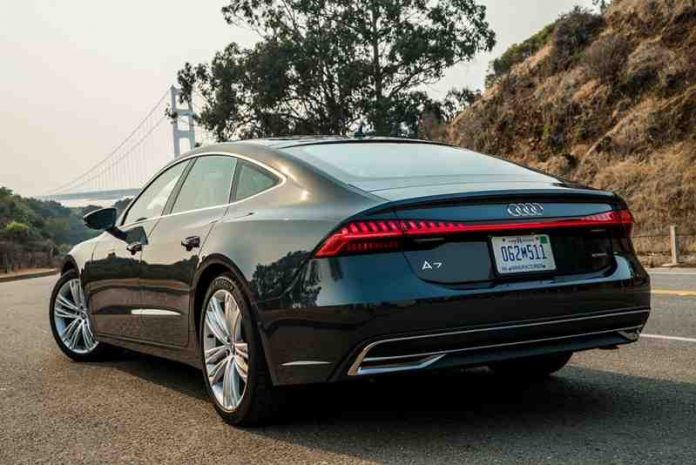











Driving a rental RAV4, which has the ASS stop start thing – but better. If you brake lightly to a halt, the engine keeps running. The ASS only kicks in if you press hard on the brake pedal at stop lights – which I never did.
Nice workaround.
The downscale trim level of the RAV4 that doesn’t have ASS gets – drumroll – 27 mph city instead of 28.
The price & complexity goes up and my interest & enthusiasm goes down
Buy a gasoline/diesel fueled generator for some electricity to charge your electric vehickle.
EVs will ensure you are a hick from the sticks.
The spirit is willing but the flesh is stupid.
‘Audi has announced it will sell only electric cars by the 2026 model year.’ — EP
This is a declaration of bad faith, strongly suggesting that the manufacturer’s support for warranty, expensive parts, etc will be a low priority, starting any time now.
As ol’ P T Barnum used to say to disperse the crowds of gawking rubes, ‘This way to the egress, folks!‘
They thought the egress was a baby eagle.
Beautiful car. I could see owning/leasing one only while it’s under warranty, it’s so darn complex.
Hate to be the guy at 5+ years old.
Guess I’m still a charger/300 v8 guy at heart. Simple, inexpensive (relative), fast and fun.
Hi Chris,
Ditto. I drive these cars and enjoy the time in them. Then I think about what it would be like to own one after the warranty runs out. And I enjoy my old truck even more!
So True! It seems like eventually most cars will be electric. Perhaps that will be a good thing on many levels. But, there remains so much work to be done, such as improving and hardening the electrical grid. We will be driving gas powered cars for many more years. Eventually through the economies of scale, and improvements in battery technology, fuel cell, or some other technology changes will happen. I am almost 70 years young, and just purchased a 2018 Porsche Panamera 4 e-Hybrid. It is a fantastic car, and cost me about what I paid for my first house many years ago. Hybrid technology makes more sense to me at this time. I’m an old gearhead, and miss some of my old 70’s muscle cars, but this car has surpassed my expectations. It’s not perfect, but it makes me happy. Oh yes, it is also the fastest, best handling car I have owned to date. Not as quick as a Tesla, but I have no range worries.
Most of these plug in hybrids are due to the no ICE zones cropping up all over the EU.
The introduction of LEZs throughout Europe is part of a larger political movement. By progressively prohibiting high-emission vehicles from European city centers, authorities encourage their citizens to consider new modes of transport as the best way to protect the environment. Electric cars, in particular, have unanimous support: their complete lack of greenhouse gas and other exhaust emissions make them the perfect vehicle for driving freely through Europe’s LEZs!
https://easyelectriclife.groupe.renault.com/en/outlook/cities-planning/low-emission-zones-lezs-in-europe/